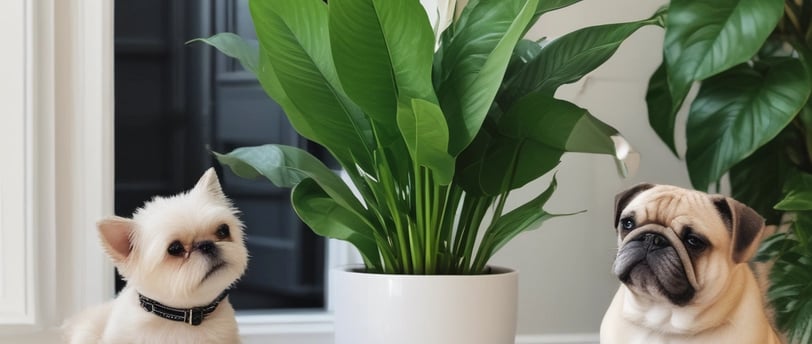Plants Toxic to Pets - Keeping Your Fur Friends Safe
How to keep your pets safe when building your indoor garden. Guide to picking pet-safe plants, and ways to enjoy your favorite plants while keeping your pets safe!
PlantyShanty.com
3 min read


Most Toxic Plants for Pets and Fur Friends: Essential Awareness for Pet Owners
Note: This post may contain affiliate links. PlantyShanty.com earns a small commission on qualifying purchases through these links at no extra cost to you. This helps us continue providing quality content for fellow plant lovers.
Many pet owners may not realize that certain household plants can pose serious risks to their furry companions. Identifying the most toxic plants for pets is crucial to ensure their safety and well-being. This blog post will explore common plants that can be harmful, enabling pet owners to make informed decisions about their home greenery.
From lilies to philodendrons, some plants can lead to severe health issues if ingested by pets. It's essential to understand which plants to avoid in order to create a safe environment for animals. This knowledge can prevent accidents and ensure that pets remain healthy and happy.
Readers will gain insights into the symptoms of plant poisoning and tips for pet-proofing their homes. By being proactive, pet owners can protect their loved ones from potential dangers lurking in their living spaces.
Common Toxic Plants for Household Pets
Certain plants commonly found in households can pose severe risks to pets. It is essential for pet owners to be aware of these plants to prevent accidental poisonings.
Lilies and Their Threat to Cats
Lilies are highly toxic to cats, with certain species such as Easter lilies, tiger lilies, and true lilies being particularly dangerous. Ingesting even a small amount can lead to acute kidney failure in felines. Symptoms of lily poisoning include vomiting, lethargy, and loss of appetite.
If a cat consumes lily parts, immediate veterinary attention is crucial. Prompt treatment can involve inducing vomiting and administering activated charcoal. Pet owners should ensure lilies are kept out of reach and consider alternatives like safe houseplants.
Sago Palm Poisoning in Dogs
The sago palm, often admired for its palm-like appearance, contains toxins that are harmful to dogs. All parts of the plant are poisonous, especially the seeds. Ingestion can cause severe liver failure, which may be fatal.
Signs of sago palm poisoning include vomiting, diarrhea, seizures, and jaundice. Immediate veterinary care is necessary if ingestion is suspected. Treatment may include decontamination measures and supportive care to manage liver function. Awareness and removal of sago palms from gardens or homes can prevent these incidents.
Oleander Risks to Pets
Oleander is an ornamental plant known for its beautiful flowers, but it is extremely toxic to both dogs and cats. It contains compounds that can affect the heart, leading to severe complications like arrhythmias and potentially death.
Symptoms of oleander poisoning include drooling, diarrhea, slowed heart rate, and weakness. Pets that consume any part of this plant require urgent veterinary attention. Keeping oleander away from pet-accessible areas is essential to avoid accidental ingestion of this dangerous plant.
Prevention and Safety Measures
Taking proactive steps can significantly reduce the risk of pet poisoning from toxic plants. Awareness and preparation play key roles in ensuring a safe environment for pets.
Identifying Toxic Plants
Recognizing toxic plants is crucial for safeguarding pets. Some common toxic plants include:
Peace Lily: Can cause oral irritation and vomiting.
Philodendron: Results in swollen lips and tongue.
Sago Palm: Highly toxic, leading to liver failure if ingested.
Pet owners should consult resources such as the ASPCA's toxic plant list or seek guidance from veterinarians. It's beneficial to familiarize oneself with local flora and avoid introducing these plants into the home or garden.
Creating a Pet-Safe Environment
Creating a space free from toxic plants requires thoughtful planning. Take the following actions:
Research Plants: Prioritize non-toxic plants for indoor and outdoor areas.
Physical Barriers: Use fencing or barriers to keep pets away from hazardous areas.
Regular Inspections: Routinely check home and garden for any new plants or weeds.
Storing any plant cuttings or gardening materials securely can help prevent accidental ingestion. An informed approach ensures pets remain safe from harmful vegetation.
Emergency Response to Poisoning
In the unfortunate event of suspected poisoning, immediate action is critical. Steps include:
Recognizing Symptoms: Watch for vomiting, diarrhea, lethargy, or difficulty breathing.
Contacting a Veterinarian: Call a veterinarian or an emergency animal poison hotline right away.
Have Information Ready: Provide details about the suspected plant and symptoms observed.
Staying calm during this stressful time will help in obtaining the best possible care for the pet. Having emergency numbers readily available can save valuable time.
Has your dog had its monthly flea treatment? Follow the link to keep your fur friend protected!
